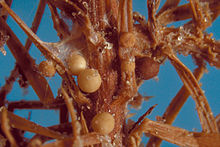Athelia rolfsii
| Athelia rolfsii | |
|---|---|
 |
|
| Sclerotia of Athelia rolfsii at base of foliage of eastern redcedar (Juniperus virginiana L.) | |
| Scientific classification | |
| Kingdom: | Fungi |
| Division: | Basidiomycota |
| Class: | Agaricomycetes |
| Order: | Atheliales |
| Family: | Atheliaceae |
| Genus: | Athelia |
| Binomial name | |
|
Athelia rolfsii (Curzi) C.C. Tu & Kimbr. |
|
| Synonyms | |
|
Corticium rolfsii Curzi |
|
Corticium rolfsii Curzi
Pellicularia rolfsii (Curzi) E. West
Botryobasidium rolfsii (Curzi) Venkatar.
Sclerotium rolfsii anamorph Sacc.
Athelia rolfsii is a corticioid fungus in the family Atheliaceae. It is a facultative plant pathogen and is the causal agent of "southern blight" disease in crops.
The species was first described in 1911 by Italian mycologist Pier Andrea Saccardo, based on specimens sent to him by Peter Henry Rolfs who considered the unnamed fungus to be the cause of tomato blight in Florida. The specimens sent to Saccardo were sterile, consisting of hyphae and sclerotia. He placed the species in the old form genus Sclerotium, naming it Sclerotium rolfsii. It is, however, not a species of Sclerotium in the strict sense.
In 1932, Mario Curzi discovered that the teleomorph (spore-bearing state) was a corticioid fungus and accordingly placed the species in the form genus Corticium. With a move to a more natural classification of fungi, Corticium rolfsii was transferred to Athelia in 1978.
The fungus produces effused basidiocarps (fruit bodies) that are smooth and white. Microscopically, they consist of ribbon-like hyphae with clamp connections. Basidia are club-shaped, bearing four smooth, ellipsoid basidiospores, measuring 4-7 by 3-5 μm. Small, brownish sclerotia (hyphal propagules) are also formed, arising from the hyphae.
...
Wikipedia
